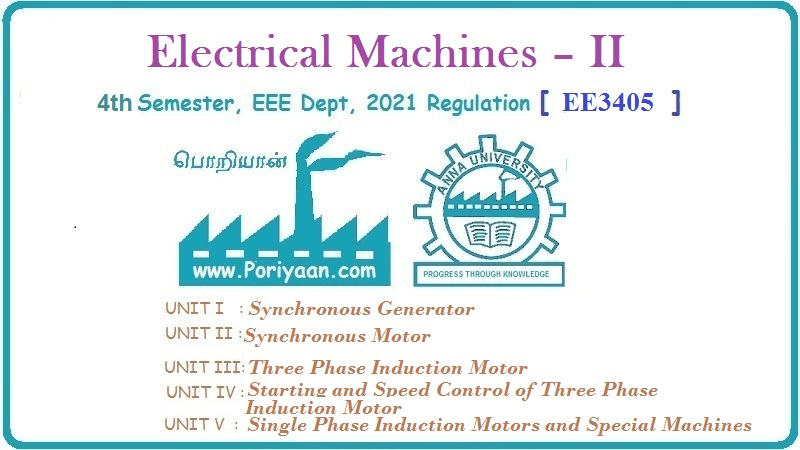Electrical Machines II: UNIT I: b. Armature Reaction and Regulation of Alternators
ASA Modification of M.M.F. Method
Synchronous Generator or Alternators
We have seen that neither of the two methods, M.M.F. method and E.M.F. method is capable of giving the reliable values of the voltage regulation. The error in the results of these methods is mainly due to the two reasons,
ASA Modification of M.M.F. Method
We
have seen that neither of the two methods, M.M.F. method and E.M.F. method is
capable of giving the reliable values of the voltage regulation. The error in
the results of these methods is mainly due to the two reasons,
1.
In these methods, the magnetic circuit is assumed to be unsaturated. This
assumption is unrealistic as in practice. It is not possible to have completely
unsaturated magnetic circuit.
2.
In salient pole alternators, it is not correct to combine field ampere turns
and armature ampere turns. This is because the field winding is always
concentrated on a pole core while the armature winding is always distributed.
Similarly the field and armature M.M.F.S act on magnetic circuits having
different reluctances in case of salient pole machine hence phasor combination
of field and armature M.M.F. is not fully justified.
Inspite
of these short comings, due to the simplicity of constructions the ASA modified
form of M.M.F. method is very commonly used for the calculation of voltage
regulation.
Consider
the phasor diagram according to the M.M.F. method as shown in the Fig. 2.16.1
for cos lagging p.f. load.

The
FR is resultant excitation of FO and FAR where FO
is excitation required to produce rated terminal voltage on open circuit while
FAR is M.M.F. required for balancing armature reaction effect.
Thus OB = FR = Resultant M.M.F.
The
angle between FAR and perpendicular to FO ϕ is , where
cos ϕ is power factor of the load.
But
OB = FR = resultant is based on the assumption of unsaturated
magnetic circuit which is not true in practice. Actually M.M.F. equal to BB' is
additionally required to take into account the effect of partially saturated
magnetic field. Thus the total excitation required is OB' rather than OB.
Let
us see method of determining the additional excitation needed to take into
account effect of partially saturated magnetic circuit.
Construct
the no load saturation characteristics i.e. O.C.C. and zero power factor
characteristics. Draw the potier triangle as discussed earlier and determine
the leakage reactance XL for the alternator. The excitation
necessary to balance armature reaction can also be obtained from the Potier
triangle. The armature resistance is known.
Now 
Construct
ASA diagram, and draw phasor diagram related to the above equation.
The
ASA diagram has x-axis as field current and y-axis as the open circuit voltage.
Draw O.C.C. on the ASA diagram. Then asstuning x-axis as current phasor, draw Vph
at angle ϕ , above the horizontal. The Vph is the rated terminal
voltage. Add IaRa in phase with Ia i.e.
horizontal and IaXL perpendicular to IaRa
to Vph. This gives the voltage Elph.
Now
with O as a centre and radius Elph draw an arc which will intersect
y-axis at E1. From E1 draw
horizontal line intersecting both air gap line and O.C.C. These points of
intersection are say B and B'. The distance between the points BB'
corresponding to the field current scale gives the additional excitation
required to take into account effect of partially saturated field. Adding this
to FR we get the total excitation as FR. From this FR, the open circuit voltage
Eph can be determined from O.C.C. using which the regulation can be determined.
The ASA diagram is shown in the Fig. 2.16.2.

The
results obtained by ASA method are reliable for both salient as well as
nonsalient pole machines.
Review Question
1. Explain the ASA method of determine the regulation of an
alternator.
Electrical Machines II: UNIT I: b. Armature Reaction and Regulation of Alternators : Tag: Engineering Electrical Machines - II : Synchronous Generator or Alternators - ASA Modification of M.M.F. Method
Related Topics
Related Subjects
Electrical Machines II
EE3405 Machine 2 EM 2 4th Semester EEE Dept | 2021 Regulation | 4th Semester EEE Dept 2021 Regulation
